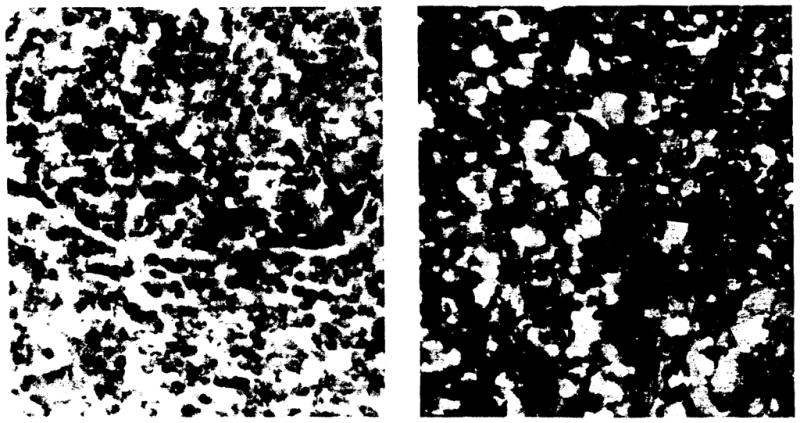Sir,—Donor (LEW) dendritic cell dissemination into recipient (BN) tissues was assessed in rats 16, 30, and 70 days after orthotopic liver transplantation (n = 3) and 30 days after intra-abdominal heart transplantation (n = 4), according to previously described surgical techniques.1 Intramuscular FK 506 (1 mg/kg) was given to liver recipients daily for 7 days, but continued for 14 days in heart recipients because of the greater vulnerability to rejection of cardiac compared with hepatic grafts.2 The same doses were then continued twice a week. Immunolabelling with a mouse monoclonal antibody, L-21-6, which recognises the invariant chain of LEW and most other rat strains, but not BN class II MHC antigen,3 allowed the distinction of donor from recipient cells.
L-21-6+ (donor) dendritic-shaped cells were detected in lymphoid tissues of the non-rejecting LEW-BN liver recipients at 16, 30, and 70 days. These cells were restricted to the periarterial lymphatic sheaths of the spleen, and the paracortex of mesenteric, cervical, and intrathoracic lymph nodes, but diminished with time (figure). Occasional cells were also detected in the thymic medulla and non-lymphoid organs, such as the heart and skin, but not the brain. Liver allografts showed mild mononuclear infiltration with increased numbers of mast cells, but there was no evidence of parenchymal damage or obliterative arteriopathy. Residual donor (L-21-6 +) dendritic cells were present in portal tracts and beneath the terminal hepatic venules at all time points examined.
Figure 1. Donor-recipient histological changes one month after rat liver allotransplantation under FK 506 immunosuppression.

Periarterial lymphatic sheath of spleen (left); thymic medulla (right). Immunoperoxidase stain with L-21-6 monoclonal antibody and haematoxylin counter stain (× 300–× 500).
Despite a longer period of daily FK 506 treatment, heart allografts had obliterative arteriopathy, indicating low-grade graft rejection. As in the liver transplants, the mild cellular infiltrate in heart allografts contained increased numbers of mast cells. An estimated one quarter of the normal quantity of dendritic cells in the cardiac graft interstitium and around blood vessels was identified as the persistent L-21-6 + (donor) phenotype. Unlike liver recipients, heart recipients had only rare donor dendritic cells in their spleen and lymph nodes, none in thymus, and none in non-lymphoid tissues, skin, lung, native heart, adrenal glands, kidneys, liver, intestines, and brain.
When liver transplantation was done across the immunologically more difficult ACI-BN strain barrier (n=3), donor cell dissemination to extrahepatic tissues at 30 days resembled that after LEW-BN cardiac allotransplantation. Donor dendritic cells persisted irregularly in the liver grafts but were sparse or undetectable at extrahepatic sites.
Acknowledgments
This research was partly funded by Project Grant No DK 29961 from the National Institutes of Health, Bethesda, Maryland.
References
- 1.Murase N, Kim DG, Todo S, Cramer DV, Fung JJ, Starzl TE. Suppression of allograft rejection with FK 506 I: prolonged cardiac and liver survival in rats following short theraphy. Transplantation. 1990;50:186–89. doi: 10.1097/00007890-199008000-00002. [DOI] [PMC free article] [PubMed] [Google Scholar]
- 2.Murase N, Kim DG, Todo S, Cramer DV, Fung JJ, Starzl TE. FK 506 suppression of heart and liver allograft rejection II: the induction of graft acceptance in rat. Transplantation. 1990;50:739–44. doi: 10.1097/00007890-199011000-00002. [DOI] [PMC free article] [PubMed] [Google Scholar]
- 3.Murase N, Demetris AJ, Matsuzaki T, et al. Long survival in rats after multivisceral versus isolated small bowel allotransplantation under FK 506. Surgery. 1991;110:87–98. [PMC free article] [PubMed] [Google Scholar]


